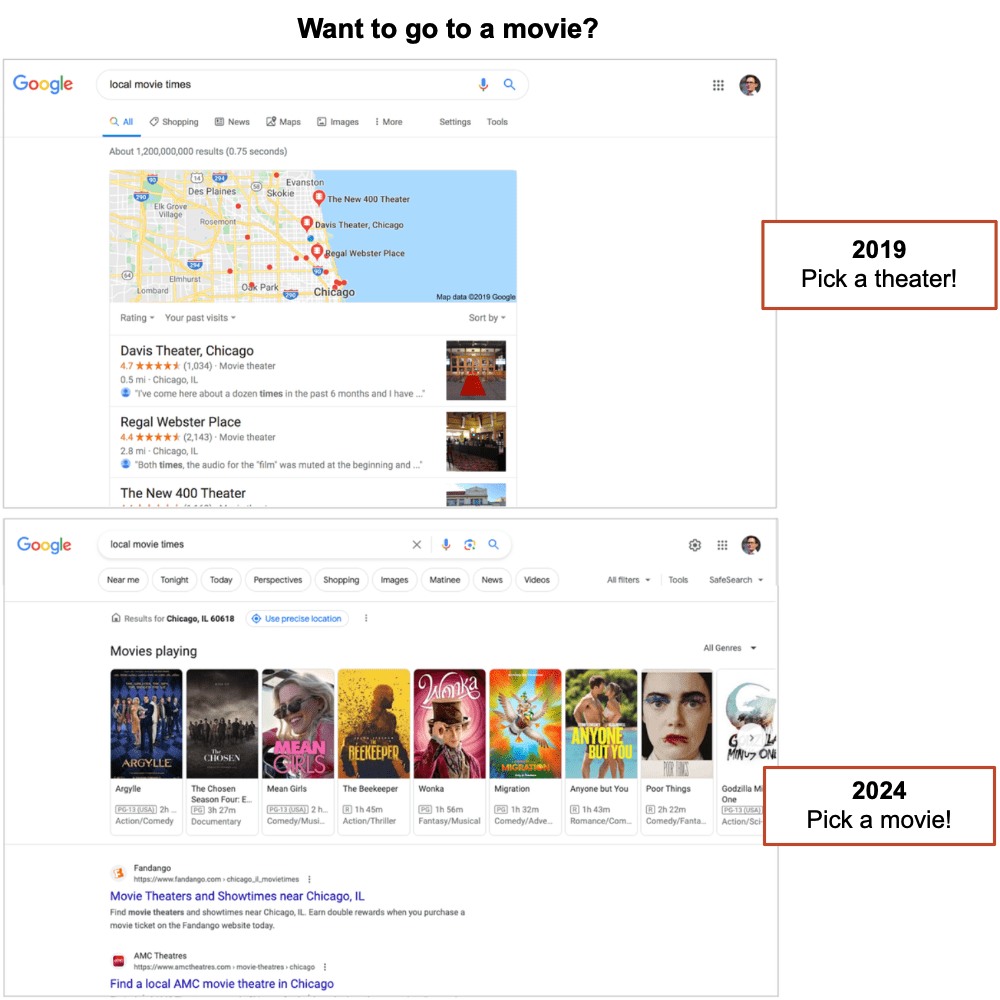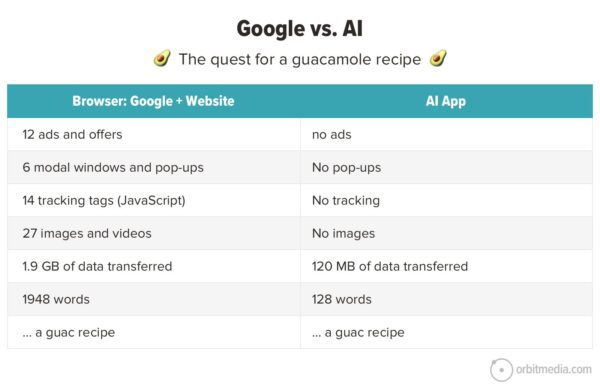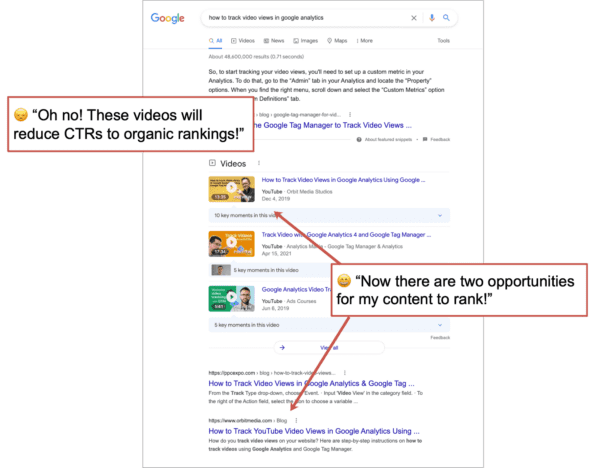I’ve collected screenshots of Google search results for many years. Every few years, we publish this post showing how Google has changed. Although the evolution is gradual over decades, the changes are huge, as you’ll soon see.
This post is a simple, visual analysis of the evolution of Google search engine results pages (SERPs). You’ll see that the big change isn’t in the rankings. The big change is what appears in search results. It’s all the “SERP features” including the new addition of generative AI.
With AI, we may be on the edge of a revolution, not an evolution, in how search works. Google’s new “search generative experience” (SGE) is a completely different experience.
At the end of this post (or go there now), we’ll show you what might be an even bigger change, a shift away from search engines and toward AI apps. Here’s a quick, video demonstration of the difference:
We’ll come back to that at the end of this post. For now, let’s look at the best examples of the biggest SEO trend, taken from hundreds of SERPs going back 10+ years. Then we’ll share tips for adapting your marketing and SEO to these changes.
Travel back in time with me…
In 2014, if you searched for skin care products, you’d have seen something like this:
 Ah, those were the days. The colors, the columns, the obvious ads. Even then, images and stars were starting to appear, but this was just the beginning.
Ah, those were the days. The colors, the columns, the obvious ads. Even then, images and stars were starting to appear, but this was just the beginning.
Month after month, year after year, Google search results kept changing. It is a slow but continuous evolution toward a more visual, more engaging experience.
Page one in Google: 2016 vs 2024
More features in more search results pages reduce the visual prominence of organic rankings, thereby reducing CTRs and traffic to websites. Here is a side-by-side comparison of two search results pages for the phrase “modern wedding dresses.”
In 2016, the search results helped visitors find websites with wedding dresses.
In 2024, the search results look more like a bridal magazine. You can browse dozens of dresses without visiting another website.

Note: The screenshot on the right is an approximation of “page one” made by scrolling down far enough to see 8 organic listings. But Google users in the US don’t see pagination. We’re in an infinite scroll experience with a “More Results” button somewhere near where the bottom of page two used to be. Now everyone is on page one of Google!
SERP feature changes, tracked over time…
More searches than ever are showing images, videos, “People also ask” boxes, maps and featured snippets. Here we track the search results for the phrase “How to write a headline” over three years…
Same query, but the SERP transforms from “ten blue links” to a richer, more interactive page with features filling the viewport above the fold, pushing down organic listings. This both reduces the need that visitors need to click on anything, and increases the likelihood that if they do click, they’ll click on another Alphabet/Google product (images, ads, maps, YouTube).
And then finally, the entire viewport is filled with AI-generated content, sourced from a selection of the organic listings.
It’s easy to understand the growing trend of zero-click searches.
SEO example: Rankings, CTR and Traffic
Let’s look at the performance of a specific page. Our excellent research piece about web design standards has ranked well for many years. We use Moz to track the rankings. We use Google Search Console to track the clickthrough rates (CTR). We use GA4 to track the traffic.
When we map these three together and look at a one year period, you can see the rank holding steady, but the CTRs fall and the organic traffic falls. Take a look:

Google rankings change slowly.
Google search results pages change fast.
Rankings are durable. Placement is not.
Surprised at how little the ranking changed over the years? I am not. That page has ranked at or near the top of search results for nine years.
In our experience, pages that rank well tend to continue to rank well over long periods of time. Many rankings are very durable, often holding a position for five years or longer.
What affects the rate at which rankings change? The durability of a search ranking depends on the rate at which new pages are published on that topic.
Ranking fluctuations are more a function of the topic than the algorithm. There are many sleepy corners of the internet where a URL can hold a top spot for 10+ years, simply because there isn’t a lot of new content published on that topic.
Ranking algorithm updates are real, but they aren’t the big change affecting search and SEO. The biggest change is visible to everyone, plain as day. It’s the SERP features (featured snippets, maps, images, videos, etc.). There’s just a lot more stuff showing up in search results these days.
Here is a list of SERP features. This chart shows when they first appeared and the likelihood that they appeared three years ago compared to early 2024, according to MozCast.

 |
Cyrus Shepard, Founder of Zyppy“Many SEOs see Google’s changing SERPs as reduced traffic potential—which is undoubtedly true—but there is another side to the story: increased search result complexity opens new arenas of opportunity. Case in point: Google Shopping results have changed so fast and become so complex that very few merchants can claim to be optimized. A smart retailer or SEO can take advantage of these under-optimized areas for outsized gains. Unlike traditional “10 blue links,” which have become optimized to death, new SERP features offer websites a chance for search visibility in non-traditional ways. In only the past 18 months, we’ve seen significant changes in the way Google handles site names, icons, forum markup, video rankings, SGE, shopping feeds, and image search, to name a few. Most sites are far behind in optimizing for these new realities. Smart marketers are picking new battlegrounds to enter to help them survive whatever increasingly squeezed future Google may throw our way.” |
A more visual experience
In the last few years, Google has added many more visual SERP features for many queries, including lots of carousels. These clicks basically refine the search results, which might be great for visitors and Google, but often reduce clicks and traffic to websites and businesses.
For example, imagine you’re looking to go to a show and you search for “local movie times” then and now
- In 2019, you saw a local three pack. Click to consider a business.
- In 2024, you see a carousel of movies. Click to see refined search results.

Videos are bigger and appear more often
Videos have appeared in search results, as rich snippets, since 2012. They were basically a search listing (aka “search snippet”) like any other, but with a video thumbnail.
But in 2018, things changed. That’s when the video carousel first appeared. At first, it was just three video thumbnails.
Since then, it’s been redesigned several times, always getting bigger and more interactive. And of course, flipping from horizontal to vertical means more videos can be added within the viewport.
Take a look at the change over 10 years:
More engagement on the carousel means less engagement on organic listings and better odds that the visitor stays within the search results.
Changes in PPC ads
Google is a wonderful way to find useful websites. But those clicks on those organic rankings don’t pay their bills. Google only generates revenue when we click on ads. Then they get paid per click. And in 2023 those clicks generated $250B in revenue, up 5x over the last 10 years.
That increase could be explained by more searches or higher prices, but also because Google has found ways to increase the clickthrough rates for ads.
If I were a designer at Google, hoping to increase CTR on PPC ads, I’d make them bigger. Or I’d add more opportunities to click. Or I’d try to blend them in more with organic listings.
Google has done all of those things.

Assuming the landing pages are helpful, high clickthrough rates on ads are good for searchers, good for advertisers and good for Google. This isn’t a conspiracy. It’s ethical commerce with mutual benefits for everyone involved.
The organic rankings below these ads aren’t really involved.
Google’s new Search Generative Experience (SGE) and the impact
Google Search is responding to AI by adding a complete new user experience to search results. This experimental new feature is called “Search Generative Experience” and it is a very different UX.
If you haven’t turned on SGE, you may not have noticed.
If you have turned it on, you’re seeing something completely new at the top of every search results page. You may see familiar elements (maps, carousels) but Google isn’t retrieving information from data sources, it is generating information using AI.
In January 2024, Authoritas did an SGE research study to learn the impact on search results. They ran 1000 mainly ecommerce queries through Google with SGE enabled. Here is a quick summary of what they found:
- Google shows an SGE element in 87% of all search queries.
- When it does, 66% of search results show a small ‘Generate’ button. 34% of searches show an SGE element with a ‘Show More’ link.
- Clicking the ‘Show More’ link pushes the organic listings down 1,500+ pixels, filling the entire viewport.
- SGE content shows an average of 10 links from 4 unique domains.
- 94% of SGE links came from sources outside the top-ranking organic domains. With only 4.5% of generative URLs directly matching a page one organic listings.
Here’s what it looks like in the wild. Similar to a giant featured snippet, Google is summarizing the main points from many URLs.
Basically, Google is writing a tiny blog post for the searcher.

Google vs. AI apps: An even bigger disruption
If you feel that SERP changes are hurting your traffic and disrupting your business, this may cheer you up.
Google itself is threatened by AI.
Ultimately, AI technology may change how we all use the web, which may dramatically impact the use of search engines.
If internet users decide that browsers and search engines are a noisy, distracting way to use the internet, we may start using AI apps to get basic information. They may find that apps are a cleaner, faster, easier, more private experience.
This video shows a side-by-side comparison for two experiences within a single use case: getting a guacamole recipe. This is a summary of what we showed in the video above.

Of course, having information generated for you on demand has limitations.
- AI generated content is not current. AI isn’t good for new information. (example: news)
- AI generated content is not curated. You’re not likely to discover something unexpected (example: social media)
- AI generated content has no point of view. It doesn’t produce recommendations, opinions or op-ed content. (example: thought leadership)
- AI generated content is mostly text, for now at least. Video based answers aren’t available (example: how to install a child’s car seat)
You could also argue that AI generated content isn’t accurate, but its degree of accuracy is similar to the internet in general. It was trained on the internet. Of course it’s not accurate.
 |
Corey Northcutt, Chief Optimization Officer, Orbit Media“Decisions need to be made about how to compete in a new era of search. For technical SEO, should you block AI trainers universally, partially, or not at all from your website? And if so, which ones? For creative SEO, is it finally time to stop writing those top-of-funnel help articles? And how can you write more novel, precise content that speaks to your brand, market, and ecosystem in a way that GPT avoids, yet Google rewards?” |
So for many use cases, search is safe and Google shouldn’t worry. But no one is completely safe and the era of 10% growth in ad revenue won’t last forever. Ask anyone who sold ads for newspapers in the early 2000’s.

So what’s a digital marketer to do? 5 ways to adapt to changing SERPs.
First, there’s no use complaining about it. That’s like a farmer complaining about the weather. It’s pointless. If you can’t control something, work around it. Work with it. Adapt.
Yes, Google has gotten better at keeping people on its website through some basic UX changes to search results.
- More visuals (images and videos)
- More types of media/formatting (stories, questions, carousels, widgets)
- More opportunities to click (50+ links and buttons on many SERPs)
- Longer pages
They have done years of research and spent millions on testing to create a high-engagement experience for visitors and this is how they’ve changed.
Here are 5 ways that the digital marketer can adapt to this ever-evolving reality.
1. Make your own website more engaging
The first lesson is that these types of changes work. Google knows how to improve visitor engagement. And we can apply them on our own websites.
Look at your pages and ask yourself if you can’t make your own, Google-style improvements.
- Add more visuals (images and videos)
- Add more types of formatting (subheads, lists, quotes/testimonials, bullets)
- Add more opportunities to click (internal links, jump links, calls to action)
- Longer pages (detail, depth, examples, stories)
2. Work hard on your headlines (write high CTR title tags)
If you rank and the visitor sees your search listing, they’ll do a split-second cost-benefit analysis. Is this click worth 2-seconds of my time?
If yes, you earned a visitor. This is how great headlines work.

To increase the clickthrough rate to your page, write a title tag with a headline that works with the psychology of the potential visitor. There are three ways the headline does this:
- The benefits look high
The reason to click is obvious and specific. Make a strong promise, but don’t oversell it.
“Complete guide to increasing clickthrough rates and maximizing traffic to any post” - The cost seems low
The content sounds scannable and is fast or easy to consume. Indicate it’s a list or has visuals.
“5 Quick ways to increase your clickthrough rate (plus 12 examples)” - It’s unexpected
Use a weird word in your title tags. Make it stand out. Make it interesting or interesting.
“Lessons from a reformed spammer about increasing clickthrough rates”
Social media and email pros are experts at triggering the psychology that triggers clicks. But SEOs often just cram in keywords without thinking much about human psychology. See what’s working in a social and email, then go update your titles for your high ranking, low CTR pages.
3. Publish videos
If you know what format is winning for a target keyphrase, publish content in that format.
If you see videos in the search results for the phrase you’re considering, publish videos.
If you can’t beat them, join them. There really is no other choice.
- The SEO pessimist complains that the video carousel reduces CTR to pages.
- The SEO optimist sees an opportunity to win two spots in the search results.

Because the videos within video carousels are almost always videos from YouTube, post the videos there. To jump start the views of the video, embed it at the top of a relevant, high ranking page. This is an automatically successful YouTube content strategy. Success is guaranteed.
4. Target visit website-intent, not fact-intent keywords
When a quick answer is all the searcher needs, you can bet that Google will satisfy that information need in the search results. in a featured snippet, “People also ask” box or some other widget. Fact-intent queries are typical “zero-click” searches.
No need to click on anything.
No one will ever get traffic from these phrases again.
So don’t bother targeting these keyphrases. A detailed and well structured page will rank for dozens of phrases, including some fact-intent phrases. But these shouldn’t be the primary keyphrase for any URLs.

The reality is that for years now, most searches are zero-click searches.
Remember the early 2000’s when publishing a glossary was a viable SEO strategy? This is why no one does that anymore.
Focus first on the phrases that visitors search for when they’re looking to get long-form detailed answers. Or commercial-intent phrases where visitors are considering options for help. Visitors who search for these phrases are looking to go to a website.
5. Don’t give up, but don’t bet the farm on SEO
Search is a powerful source of qualified traffic. It has the amazing potential to grow brand awareness and generate demand. And there are still millions of great keyword opportunities. You can target any of them with just a day of research and writing.
But there is more to life than search.
In addition to search engine optimization, build up the other aspects of your marketing, digital and off-line.
- First, optimize your website for conversions.
You’ll get more value from every visitor forever after. Here’s how. - Grow your email list.
The more you grow your list, the less you rely on digital giants for traffic. Here’s how. - Write for other websites.
Publish content on any website that your audience visits. Here’s how. - Do account based content marketing.
Even the tiniest brands with no rankings or traffic can win. Here’s how.
 |
Karine Abbou, AI Marketing Educator“What changes with SGE is that organic results will now (on top of everything else listed in this blog post) essentially be made of aggregated answers from content creators all over the web, merged to provide us with “an answer” (Google’s answer!). This answer will contain even more options for clicks than ever before. Zero-click search is (really) here. What doesn’t change with SGE is that this answer could contain your brand (corporate or personal). While future consumers might not discover you by clicking through a link that will lead them to your website anymore – your brand name can still be featured within the AI-generated responses, most of the time in a pretty great way. Here are few strategies marketers should consider to be visible in SGE:
|
“Google changes every day. You have to watch your rankings.”
You hear this at big conferences and small conference rooms. But the biggest change in Google doesn’t affect your rankings.
The big change is that search results slowly transformed from the white pages into the yellow pages. This has nothing to do with rankings. The biggest factor affecting your organic traffic is your clickthrough rates, not rankings.
So now you know how it’s possible (even probably) for rankings to go up but traffic to go down. This is simply the reality of modern search marketing and SEO.
Thanks for stopping by! We’ll leave you with one final side-by-side comparison showing the changes to SERPs for a gratitude-related keyphrase. Thanks for visiting! 😄





